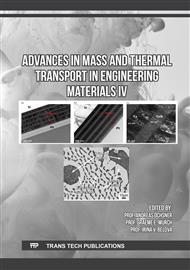p.3
p.13
p.33
p.45
p.71
p.81
p.93
p.107
Optimizing Diffusion Time and other Resources by Using the Diffusion Rate and Number of Stages Concepts
Abstract:
Considering that velocity of diffusion in a system solute-porous material-solvent depends on several factors, (among them, the concentration differential between “solute” in the porous material and “solute” in the solvent) the diffusion process will finish only when maximum entropy is achieved. Thus, the solute concentration will be equal in the matrix and in the solvent (equilibrium concept). On the other hand, if the velocity of diffusion depends on the differential of concentration, then, the amount of materials transferred per time unit (diffusion rate) will diminish as the process goes on. Moreover, when the final concentration of solute in the porous material is desired to be lower than that of the one-stage-equilibrium, then n-more stages must be added. Thus, the decision to choose a process with one or more stages, as well as the end point in each stage (as close or as far as equilibrium) will determine processing time and the use of other resources, i.e. amount of solvent, installation size, financial investment and so on. Therefore, the objective of this study is to develop a tool that helps to optimize these decisions by using a numerical approach.
Info:
Periodical:
Pages:
3-12
Citation:
Online since:
December 2023
Authors:
Keywords:
Price:
Сopyright:
© 2023 Trans Tech Publications Ltd. All Rights Reserved
Share:
Citation:


